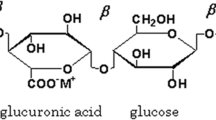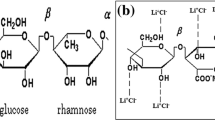Abstract
In the present work, a solid biopolymer membrane (SBPM) with gellan gum (GG) and sodium perchlorate (NaClO4) has been prepared by solution casting method for the fabrication of solid-state sodium-ion battery (SIB). The prepared SBPMs were carried out with various characterization techniques. X-ray diffraction (XRD) method confirms the crystalline/amorphous nature of the prepared biopolymer membranes (BPMs), and the membrane with the composition of 1g GG: 0.6 M.wt% of NaClO4 exhibits high amorphous nature. Fourier transform infrared (FTIR) spectroscopy reveals the complexation between the host biopolymer GG and NaClO4. The glass transition temperature (Tg) of prepared membranes is examined using differential scanning calorimetry (DSC), and the BPM with the concentration of 1g GG: 0.6 M.wt% of NaClO4 results with low Tg value (42.70 °C) in contrast to other salt-added membranes. From AC impedance analysis, the ionic conductivity calculated for pure GG is 3.87±0.15 ×10−6 S cm−1, and on addition of salt, the membrane 1g GG: 0.6 M.wt% of NaClO4 exhibits enhanced ionic conductivity of 4.85±0.11 ×10−3 S cm−1 at room temperature. Surface morphology analysis and thermal stability of the prepared BPMs have been examined using scanning electron microscopy (SEM) and thermogravimetric analysis (TGA). Transference number measurement has been done to confirm that the conduction is mainly due to ions. The electrochemical stability for the highest ion conducting membrane has been analyzed using linear sweep voltammetry (LSV). The cycling stability for the prepared biopolymer electrolyte of 1g GG: 0.6 M.wt% of NaClO4 has been obtained using cyclic voltammetry (CV) analysis. The solid-state primary sodium ion battery (SIB) has been constructed using the highest ion conducting membrane and results in an open circuit voltage (OCV) of 2.99 V.
















Similar content being viewed by others
Data availability
The datasets generated and/or analyzed during the current study are not publicly available [the paper is still not published]. But the data is available from the corresponding author upon reasonable request.
References
Abraham KM (2020) How comparable are sodium-ion batteries to lithium ion counterparts? ACS Energy Lett 5:3544–3547
Evans J, Vincent CA, Bruce PG (1987) Electrochemical measurement of transference numbers in polymer electrolytes. Polymer 28(13):2324–2328
Ye L, Feng Z (2010) Polymer electrolytes fundamentals and applications, vol 551. Wood Head Publishing Limited
Mohiuddin M, Kumar B, Haque S (2017) Biopolymer composites in photovoltaics and photodetectors. Biopolymer Compos Electron:459–486
Changyu T, Ken H, Qiang F, Pulickel MA, Haleh A (2012) High ion conducting polymer nanocomposite electrolytes using hybrid nanofillers. Nano Lett 12:1152–1156
Hadi JM, Aziz SB, Saeed RS, Brza MA, Abdulwahid RT, Hamsan MH, Abdullah MR, Kadir MF, Muzakir SK (2020) Investigation of ion transport parameters and electrochemical performance of plasticized biocompatible chitosan-based proton conducting polymer composite electrolytes. Membranes 10(11):363
Alves RD, Rodrigues LC, Andrade JR, Pawlicka A, Pereira L, Martins R, Silva MM (2013) Study and characterization of a novel polymer electrolyte based on agar doped with magnesium triflate. Mol Cryst Liq Cryst 570(1):1–11
McCray B, Vilker VL, Nobe K (1991) Reverse osmosis cellulose acetate membranes II dependence of transport properties on acetyl content. J Membr Sci 59(3):317–330
Perumal P, Selvin PC, Selvasekarapandian S, Sivaraj P (2019) Structural and electrical properties of bio-polymer pectin with LiClO4 solid electrolytes for lithium ion polymer batteries. Mater Today Proc 8:196–202
Roldan-Cruz C, Garcia-Hernandez A, Vernon-Carter EJ, Alvarez-Ramirez J (2017) Impact of insoluble starch remnants on the behavior of corn starch/glycerol/LiCl solid electrolyte. Ionics 23:1721–1732
Chitra R, Sathya P, Selvasekarapandian S, Monisha S, Moniha V, Meyvel S (2019) Synthesis and characterization of iota-carrageenan solid biopolymer electrolytes for electrochemical applications. Ionics 25(5):2147–2157
Naachiyar MR, Ragam M, Selvasekarapandian S, Aristatil G, Hazaana AS, Vignesh MN, Krishna VM (2022) Fabrication of rechargeable proton battery and PEM fuel cell using biopolymer gellan gum incorporated with NH4HCO2 solid electrolyte. J Polym Res 29(8)
Aafrin Hazaana S, Joseph A, Selvasekarapandian S, Meera Naachiyar R, Vengadesh Krishna M, Muniraj Vignesh N (2022) Development and characterization of biopolymer electrolyte based on gellan gum (GG) with lithium chloride (LiCl) for the application of electrochemical devices. Polym Bull 80(5):5291–5311
Majid SR, Sabadini RC, Kanicki J, Pawlicka A (2014) Impedance analysis of gellan gum-poly( vinyl pyrrolidone) membranes. Mol Cryst Liq Cryst 604(1):84–95
Noor ISM, Majid SR, Arof AK, Djurado D, Claro Neto S, Pawlicka A (2012) Characteristics of gellan gum-LiCF3SO3polymer electrolytes. Solid State Ion 225:649–653
Halim NFA, Majid SR, Arof AK, Kajzar F, Pawlicka A (2012) Gellan gum-lii polymer electrolytes. Mol Cryst Liq Cryst 554(1):232–238
Maithilee K, Sathya P, Selvasekarapandian S, Chitra R, Krishna MV, Meyvel S (2022) Na-ion conducting biopolymer electrolyte based on tamarind seed polysaccharide incorporated with sodium perchlorate for primary sodium-ion batteries. Ionics 28:1783–1790
Naveen Kumar P, Sasikala U, Sharma AK (2013) Investigations on conductivity and discharge profiles of novel (PEO+PEMA) polymer blend electrolyte. Int J Inno Res Sci Eng Tech 2:3575–3582
Infanta Diana M, Selvasekarapandian S, Christopher Selvin P, Vengadesh Krishna M (2022) A physicochemical elucidation of sodium perchlorate incorporated alginate biopolymer: toward all-solid-state sodium-ion battery. J Mater Sci 57:8211–8224
Jansson PE, Lindberg B, Sandford A (1983) Structural studies of gellan gum, an extracellular polysaccharide elaborated by Pseudomonas elodea. Carbohydr Res 124:135–139
Giavasis I, Harvey LM, McNeil B (2000) Gellan cum. Crit Rev Biotechnol 20:177–211
Milas M, Shi X, Rinaudo M (1990) On the physicochemical properties of gellan gum. Biopolymers 30:451–464
Ilhan Chang (2010) Biopolymer treated Korean residual soil: geotechnical behavior and applications. (Doctoral dissertation, Ph.D. Thesis)
Chang I, Lee M, Tran ATP, Lee S, Kwon YM, Im J, Cho GC (2020) Review on biopolymer-based soil treatment (BPST) technology in geotechnical engineering practices. Trans Geotech 24:100385
Liu S, Chen X, Zhang Y (2020) Hydrogels and hydrogel composites for 3D and 4D printing applications. 3D 4D Printing Polym Nanocompos Mater:427–465
Nayak AK, Hasnain MS, Pal K, Banerjee I, Pal D (2020) Gum-based hydrogels in drug delivery. In: Biopolymer-Based Formulations. Elsevier, pp 605–645
Hu D, Wu D, Huang L, Jiao Y, Li L, Lu L, Zhou C (2018) 3D bioprinting of cell-laden scaffolds for intervertebral disc regeneration. Mater Lett 223:219–222
Shah JN, Jani GK, Parikh JR (2007) Gellan gum and its applications-a review. Pharmaceutical Information, Pharamainfo, Articles and Blogs, p 5
Khan T, Park JK, Kwon J-H (2007) Functional biopolymers produced by biochemical technology considering applications in food engineering. Korean J Chem Eng 24:816–826
Silva SS, Rodrigues LC, Fernandes EM, Reis RL (2020) Fundamentals on biopolymers and global demand. In: Biopolymer Membranes and Films. Elsevier, pp 3–34
Devlin DJ, Herley PJ (1987) Thermal decomposition and dehydration of sodium perchlorate monohydrate. Reactivity Solid 3(1-2):75–84
Singh R, Bhattacharya B, Rhee HW, Singh PK (2015) Solid gellan gum polymer electrolyte for energy application. Int J Hydrogen Energy 40(30):9365–9372
Hodge RM, Edward GH, Simon GP (1996) Water absorption and states of water in semicrystalline poly (vinyl alcohol) films. Polymer 37(8):1371–1376
Sudhamania SR, Prasada MS, Sankar KU (2003) DSC and FTIR studies on gellan and polyvinyl alcohol (PVA) blend films. Food Hydrocoll 17:245–250
Monisha S, Mathavan T, Selvasekarapandian S, Benial AMF (2017) Preparation and characterization of cellulose acetate and lithium nitrate for advanced electrochemical devices. Ionics 23(10):2697–2706
Kumar D, Hashmi SA (2010) Ion transport and ion-filler-polymer interaction in poly (methyl methacrylate)-based, sodium ion conducting gel polymer electrolyte dispersed with silica nanoparticles. J Power Sources 195:5101–5108
Muthukrishnan M, Shanthi C, Selvasekarapandian S, Premkumar R (2023) Biodegradable flexible proton conducting solid biopolymer membranes based on pectin and ammonium salt for electrochemical applications. Int J Hydrogen Energy 48(14):5387–5401
Jiang X, Li H, Luo Y, Zhao Y, Hou L (2016) Studies of the plasticizing effect of different hydrophilic inorganic salts on starch/poly (vinyl alcohol) films. Int J Biol Macromol 82:223–230
Boukamp BA (1986) A package for impedance/admittance data analysis. Solid State Ion 18:136–140
Chandra MV, Karthikeyan S, Selvasekarapandian S, Pandi DV, Monisha S, Packiaseeli SA (2016) Characterization of high ionic conducting PVAc–PMMA blend-based polymer electrolyte for electrochemical applications. Ionics 22(12):2409–2424
Arof A, Naeem M, Hameed F, Jayasundara WJMJSR, Careem M, Teo L, Buraidah M (2014) Quasi solid state dye-sensitized solar cells based on polyvinyl alcohol (PVA) electrolytes containing I−/ I3− redox couple. Opt Quantum Electron 46(1):143–154
Zhang N, Li X, Ye J, Yang Y, Huang Y, Zhang X, Xiao M (2020) Effect of gellan gum and xanthan gum synergistic interactions and plasticizers on physical properties of plant-based enteric polymer films. Polymers 12(1):121
Aromaaa J, Barkerb MH, Lagerstedta A, Torkkelia J, Forséna O (2009) Evaluation of lead anodes and their tendency to manganese dioxide deposition. In: Proceedings of EMC,GDMB, Clausthal-Zellerfeld, p 1
Sulcius A (2008) Interpretation of voltaic cells in chemistry education. J Sci Educ 9(2):114–116
Diana MI, Selvin PC, Selvasekarapandian S, Krishna MV (2021) Investigations on Na-ion conducting electrolyte based on sodium alginate biopolymer for all-solid-state sodium-ion batteries. J Solid State Electrochem 25:2009–2020
Karthika JS, Vishalakshi B, Naik J (2016) Gellan gum–graft– polyaniline—an electric conducting biopolymer. Int J Biol Macromol 82:61–67
Author information
Authors and Affiliations
Contributions
The entire work has been done by Kani Ajay Babu M and the full manuscript is written by Kani Ajay Babu M. The full manuscript has been corrected by Jayabalakrishnan S. S. The concept of the work is given by Selvasekarapandian S. AC impedance analysis has been done by Aafrin Hazaana S. and Muniraj @ Vignesh N. Construction of primary sodium-ion battery has been done by Meera Naachiyar R.
Corresponding author
Ethics declarations
Ethics approval
Not applicable.
Conflict of interest
The authors declare no competing interests.
Additional information
Publisher’s Note
Springer Nature remains neutral with regard to jurisdictional claims in published maps and institutional affiliations.
Rights and permissions
Springer Nature or its licensor (e.g. a society or other partner) holds exclusive rights to this article under a publishing agreement with the author(s) or other rightsholder(s); author self-archiving of the accepted manuscript version of this article is solely governed by the terms of such publishing agreement and applicable law.
About this article
Cite this article
Kani Ajay Babu, M., Jayabalakrishnan, S.S., Selvasekarapandian, S. et al. Development and characterization of biopolymer electrolyte based on gellan gum for the fabrication of solid-state sodium-ion battery. Ionics 29, 5249–5265 (2023). https://doi.org/10.1007/s11581-023-05210-9
Received:
Revised:
Accepted:
Published:
Issue Date:
DOI: https://doi.org/10.1007/s11581-023-05210-9




